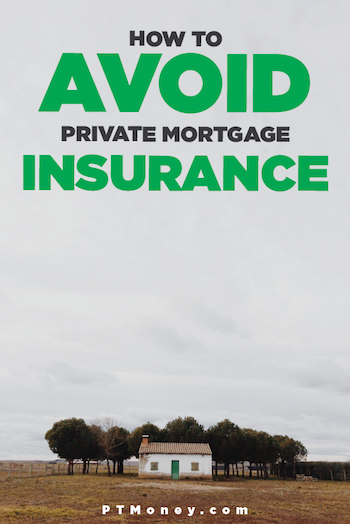What is Private Mortgage Insurance and How Can You Avoid It?
Editor’s note: Here’s an excellent contribution on the subject of PMI from my friend Ben Feldman.
I recently reached that time in life where I’m starting to think about buying a home.
I’m ready to settle down, and I like the idea of owning my own place. As I’ve begun to do my research, I’ve also realized how overwhelming the whole process can feel.
There are a lot of things to consider when buying a home — from which neighborhood you want to live in, to how big of a home you want, to the type of mortgage that is best for you.
But one thing that tends to get forgotten during the home-buying process is all the extra costs you might have to pay on top of the price of the home. One of those extra costs is private mortgage insurance (PMI), and according to some estimates, homeowners might pay anywhere from $100 to $500 per month for PMI.
There are ways to avoid paying it, depending on what kind of financing you use to purchase your home.
Not everyone needs to pay private mortgage insurance, but every prospective home buyer should understand how it works and be able to evaluate whether they need it or not.
What Is Private Mortgage Insurance (PMI)?
In most cases, when you pay for any type of insurance, it means you’re protected in some way from unexpected events. However, PMI is different than other types of insurance, because PMI actually protects your lender — not you.
PMI works like an insurance policy for your lender to protect them from any losses that could happen if you default on your mortgage payments.
Unfortunately, as the homeowner, you have to pay the monthly premium for mortgage insurance even though you don’t benefit from it. Your PMI payments will be wrapped into your monthly mortgage payment along with your principal, interest, and (possibly) property taxes and property insurance.
How Much Does PMI Cost?
The amount you have to pay for PMI every month depends on your credit score and a few other factors, including the size of your loan. The larger your loan is and the lower your credit score is, the higher your PMI payment will be. Generally, PMI costs about 0.5% to 1% of the value of the loan per year.
For example, if you have strong credit and purchase a home for $400,000 with a 10% down payment, you might have to pay about $170 per month for PMI. If you have a lower credit score, you might have to pay $270 per month (or more) for the same mortgage insurance.
When Is PMI Required?
Since PMI helps your lender avoid risk, PMI is only required when your down payment is less than 20%. When you have a down payment of 20% or more, there is less risk to the lender so PMI is not required.
Even if you start out paying PMI, it doesn’t mean you have to pay it forever. In fact, your lender is required to cancel your private mortgage insurance when your loan balance drops to 78% of the home’s original price. You can also be proactive and request to have your PMI canceled when your loan balance drops to 80%.
How to Avoid PMI

Since it can take a big chunk out of your monthly budget, many home buyers search for ways to avoid paying PMI. Here are some of the most common ways:
Make a bigger down payment: One way to avoid PMI is to increase your down payment to 20%. Easier said than done, right? If you have a family member or friend who is willing to put up cash for your down payment, that would certainly help. It’s not uncommon for a parent or grandparent to invest in their child’s (or grandchild’s) home to help make their monthly payments more manageable.
Take a home ownership investment: For those who don’t have a family member with extra cash, or don’t want to burden their family, there are companies that invest alongside home buyers in their homes. These companies will give you money for your down payment in exchange for a share of the equity in the home. For example, Unison (see PT’s review) will typically contribute up to half of your down payment (sometimes more) with their Unison HomeBuyer program. In return, they share a portion of any gains or losses in the price of the home when you sell it.
Use a piggyback mortgage or 80/10/10 loan: You might be able to avoid PMI by taking out a second loan in addition to your first mortgage. This is called a “piggyback loan” or “80/10/10 loan” because it generally requires you to have a 10% down payment and to borrow an additional 10% in a second loan so that the first mortgage amount is for 80% of the home’s price.
The problem with this arrangement is that piggyback loans can be risky. They often have adjustable rates, which can increase your payments in the future, and they often need to be paid back over 15 years instead of 30 years. For those reasons, it’s usually preferable to use a 20% cash down payment when possible. It can also be more difficult to qualify for this type of financing, so not everyone has access to it.
Ask for lender-paid mortgage insurance: There is another option for avoiding PMI. You can opt for your lender to pay the mortgage insurance, which means you must pay a higher interest rate. This is called “lender-paid mortgage insurance” or LPMI. While it sounds good to have your lender pay the PMI instead of you, in reality, you are still paying the cost because of the higher interest rate (typically at least 0.5% more).
If you are seriously considering LPMI, you will need to calculate how much you stand to save on PMI compared to the extra amount you will spend on interest payments. If the math works out in your favor, then it might be worth doing. You should also keep in mind that your interest payments cover the life of the loan — whereas PMI can be canceled as soon as you’ve reached 20% equity in the home.
Talk to local community lenders: Local lenders — such as credit unions — sometimes offer programs where PMI is not required. These programs vary from state to state, so you’ll need to research such a program thoroughly before deciding whether it is a good fit for you. In many cases, these programs have specific eligibility criteria such as minimum credit scores or maximum income limits.
How to Get Rid of PMI
If you do end up getting a mortgage where you have to pay PMI, you should know that you can ask the lender to drop the insurance from your mortgage payment once you have built at least 20% equity in your home.
Furthermore, your lender is required to automatically cancel your PMI payments when your equity is equal to 22% of the price of the home or when you reach the midpoint of the loan’s term. While the PMI payment should eventually disappear, it’s best to call your lender and ask them to drop it as soon as you are eligible.
Conclusion
No matter what you ultimately choose, knowing how PMI works and understanding how to avoid it will give you a better chance of successfully purchasing a home and getting the financing that is best for you. As you go through your decision-making process, be sure to compare all the choices and focus on what makes sense for you and your family.
Benjamin Feldman is a writer and personal finance enthusiast who lives with his wife in the San Francisco Bay Area. He is currently the Director of Content at Unison, where he oversees the creation and promotion of content to educate home buyers and help them accomplish their goals.





![Avoid PMI and Keep Your Cash with Unison HomeBuyer [Review]](jpg/screenshot_20170306-142743-768x1212.jpg)

Hey…please explain like I’m five.
Where was PMI during the collapse of the housing bubble when so many home-flippers were insolvent and unable to make payments and losing their homes, causing the banks to take huge hits? Why wasn’t PMI paying off and insulating the banks? Or am I missing something?
Hey ERD. From my understanding, most of the loans were piggybacked (2nd loan to cover the margin to 20%) and there wasn’t any PMI. Another thought is that PMI doesn’t kick in until the home is sold after foreclosure (long after the owner is gone). More thoughts: http://www.pbs.org/newshour/making-sense/why-didnt-the-private-mortgage/
https://www.mtgprofessor.com/A%20-%20PMI/the_role_of_pmis_in_the_mortgage_crisis.htm
We had PMI with our first house because we were only able to put down 10% for a down payment, and although it wasn’t a huge monthly cost, I hated the fact that I was paying this extra money every month.
It took a couple of years, but thanks to monthly payments, additional payments and an increase of value in the house, we were able to refinance to get rid of the PMI.
I’ve had friends who pay hundreds of dollars extra per month for PMI; that’s a back breaker. Owning a house is important, but you have to wonder if it makes more sense to wait to buy to avoid thousands of dollars per year in fees.
Another way to avoid it is VA loans (about 7.3% of the population are eligible). PMI is not allowed on VA loans. All you have to do (or have done) is sign away parts of your life to Uncle Sam.